Capture the timeless elegance of botanical art with our collection of vintage fern prints. Perfect for adding an organic touch to any interior decor.
I’ve always fancied myself a houseplant enthusiast, with a particular fondness for ferns. However, despite my love for these green gems, I’m not very good with them. My trendy friend’s Boho-style pad is a veritable jungle, with ferns of all sizes thriving in every corner.
Tried as I might to mirror the look, I seemed only to turn my home into a fern graveyard. Enough was enough. I decided if I couldn’t grow ’em, I’d hang ’em. So, here is an array of vintage fern prints. More lively than anything you’d find in my living room – all free and in the public domain, no less!
These botanical prints, showcasing the unique charm of ferns, are the perfect remedy for those of us whose thumbs are more brown than green. They add a spritz of nature and a dab of timeless elegance to any room. And here’s the kicker: they’re low maintenance. No water, no sunlight, no problem!
Whether you’re a fan of antique art or fancy a touch of the outdoors, our vintage fern prints are a guaranteed hit. So, hang up your watering can and peruse our collection. We promise they’re the easiest ferns you’ll ever care for!

Ten Fun Fern Facts to Fertilise Your Mind”
- Prehistoric Plants: Ferns have existed for more than 300 million years before dinosaurs roamed the earth.
- Seedless Wonders: Unlike most plants, ferns don’t reproduce through seeds. Instead, they use tiny spores which can be found under their leaves.
- Vast Variety: Around 10,500 known species of ferns worldwide. They range from full-sized trees in tropical climates to petite plants in cooler regions.
- Natural Air Purifiers: Ferns are excellent at purifying the air by removing toxins. Which makes them a great indoor plant for improving air quality.
- Love for Shade: Many ferns love the shade and can grow where many other plants can’t survive, making them a popular choice for gardens with less sunlight.
- Hairy Stems: Some ferns have small hair-like scales on their stems, which protect them from pests and help them conserve water.
- The Tallest Fern: The world’s tallest fern can grow up to 25 meters high, about the same height as a six-story building!
- Symbolism: Ferns are often associated with sincerity and magic in folklore. And in New Zealand, the silver fern is a national emblem.
- Culinary Use: Some types of ferns are edible and used in various cuisines worldwide. Fiddleheads, the furled fronds of a young fern, are a popular choice.
- Fern Craze: During the Victorian era, there was a craze called “Pteridomania” or “Fern Fever”, where collecting ferns and fern-themed products became popular.
How To Download The Vintage Fern Prints
Click on the title above the fern print that you want to download. A higher-resolution fern illustration will then open in a new window. This image can then be printed or saved.
All the antique fern prints and illustrations are in the Public Domain, so you can use them however you wish.
Antique British Fern Prints 1-5
The following vintage fern illustrations are from “Our native ferns, or, A History of the British Species and their Varieties” / by E.J. Lowe 1874.
Edward Joseph Lowe (1825–1900) was a prominent British botanist and astronomer. He was mainly celebrated for his work on ferns, penning several books. Besides describing known species, he also discovered several new ones.

This Fern is widely spread in Europe, being a native of Germany, Switzerland, Lapland, Russia, Norway, Sweden, and the Caucasus.”

Print 3: The limestone Polypody
The Limestone Polypody (Gymnocarpium robertianum) is a fern native to Europe and parts of Asia. It prefers lime-rich soils, often growing in limestone cracks and cliffs. It has delicate, feather-like fronds that reach 10 to 40 cm long, and its green-to-yellow-green colour helps it blend into its surroundings.
Tolerant of shade, it’s a good choice for less sunlit gardens. This fern also helps prevent soil erosion and serves as a habitat for tiny organisms.

The Parsley Fern, or Cryptogramma crispa, is a small perennial fern that resembles parsley leaves, hence its name. Found in North America, Europe, and Asia, it thrives in rocky habitats and high altitudes.
The fern has two types of fronds: the short, bright green sterile ones and the longer, brownish fertile ones that carry spores. This hardy fern prefers well-drained soil and partial shade, and it plays a role in preventing soil erosion and providing shelter for small creatures.

Polystichum lonchitis, or the Holly Fern, is an evergreen fern native to the Northern Hemisphere. It gets its name from its glossy, holly-like fronds that grow 30 to 80 cm high. Its leaflets are arranged alternately and often angle upwards, creating a unique appearance.

Lowe British Ferns 6-10
Print 6: The Broad Prickly-Tooth Fern

Print 7: The Spiny Buckler Fern
The Spiny Buckler Fern, or Dryopteris dilatata, is a robust fern native to parts of Europe, Asia, and North America. It gets its name from its leaflets’ slightly toothed or “spiny” edges.
Reaching 1 meter high, it prefers shaded locations and moist, well-drained soil. It’s a popular choice for woodland or shade gardens thanks to its ornamental look and adaptability, including some tolerance to dryness once established.
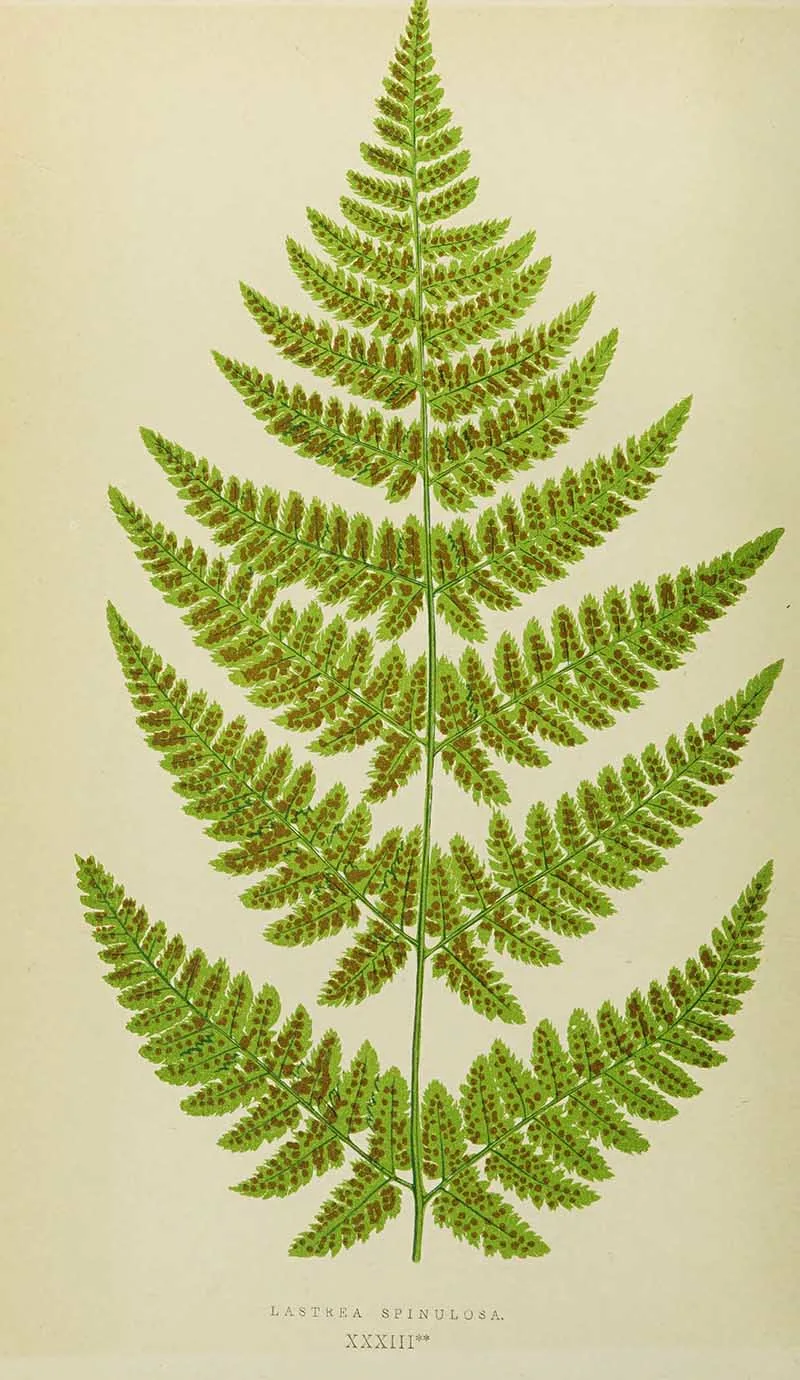
Print 8: The Angular Shield Fern
The Angular Shield Fern is an evergreen fern native to Europe and Asia. Known for its dark green, leathery fronds that form a vase-like rosette, its leaflets are distinctively angled, giving the plant its name.
The fronds can reach 60 to 100 cm long. This fern thrives in moist, well-drained, slightly acidic soil and prefers shaded areas. Its bi-pinnate fronds, divided into smaller leaflets, add ornamental value and lush texture to gardens.

The Marsh Fern is a deciduous fern native to North America, Europe, and Asia. It grows in wetlands and moist areas, reaching 60 to 90 cm. It thrives in open or lightly shaded areas.
It’s excellent for creating a natural look around ponds or in bog gardens, but it can spread aggressively if conditions are right.
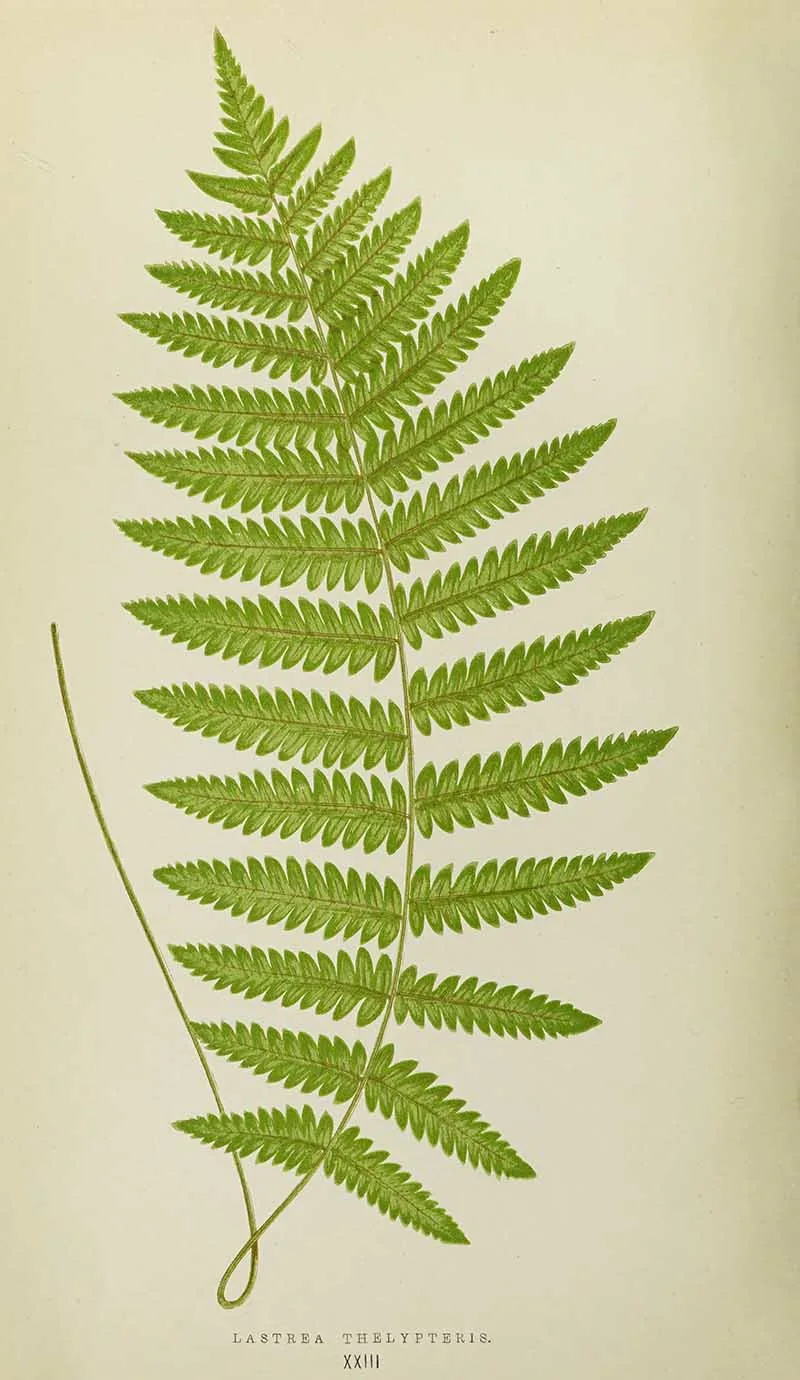
Known for their sturdy structure and attractive fronds that vary in shape and size, Wood ferns thrive in moist, well-drained soils and light conditions. Their hardiness makes them popular choices, frequently adorning shady garden borders or nestling in woodland gardens.

American Ferns Prints 11-15
The following vintage fern prints are from the book “Beautiful Ferns” by Daniel Caddy Eaton, 1886.
Daniel Cady Eaton, born in 1834, was no ordinary botanist. With a deep-rooted passion for botany, passed down from his grandfather, the famous scientist Amos Eaton, Daniel had a particular fondness for ferns. His academic journey took him from Yale to Harvard, studying under the renowned botanist Asa Gray. But Yale pulled him back, and by 1864, he became a Professor of Botany there.
Print 11: American Maiden-Hair
Watercolour fern illustration of an American Maidenhair. This fern has the common name of “Five-Fingered Fern” and comes from the plant’s distinctive appearance. Its fronds branch out in a way reminiscent of a hand’s fingers extending from a palm. This branching is unusual among ferns, adding to the plant’s distinctive charm.
It typically grows in cool, damp environments, particularly along streams and in moist woodlands. It prefers acidic soil and can tolerate both full shade and partial sun. The Five-Fingered Fern is deciduous, losing its fronds in the winter.
Its delicate, lacy fronds have a distinctive charm, which makes it popular among gardeners and those interested in ferns. Despite its delicate appearance, it’s pretty hardy and adaptable, making it an excellent choice for gardens in its native range.

The Ostrich Fern’s large, feather-like fronds can reach up to 6 feet, creating an impressive display. Thriving in cool, damp, and shady conditions, it’s perfect for woodland gardens or water features.
Interestingly, its young fronds, known as fiddleheads, are edible and considered a delicacy in some regions. However, gardeners should note that this fern can spread aggressively in favourable conditions.

Goldie’s Wood Fern is a North American native fern, mainly found in the northeastern US and eastern Canada. It’s a large fern with triangular fronds that can reach up to 1 meter in length. This fern loves cool climates, moist, well-drained soil, and shady spots.
Named after Scottish botanist John Goldie, this robust yet elegant fern is a perennial, returning yearly under the right conditions, but is relatively rare in cultivation.

Print 14: Everygreen Wood-fern
The Evergreen Wood Fern is a robust North American fern known for its year-round green fronds. The fern prefers shady locations, well-drained, organic-rich soil, and while it enjoys regular moisture, it can handle some drought.
An exciting feature is its sori, clusters of spore-producing structures, on the underside of its fronds, providing a fascinating glimpse into fern reproduction.

Walking Ferns are unique North American ferns known for their propagation method. They grow new plants at their arching frond tips, giving the appearance of the fern “walking” across surfaces.
Preferring moist, shady environments, these ferns have slender, evergreen fronds reaching 3 to 8 inches long. While slow-growing, they can form large colonies over time, making them a unique addition to shaded gardens or landscapes.

Choice Ferns Prints 16-21
The following vintage fern prints are from “The Book of choice ferns for the Garden, conservatory, and Stoves” by George Schnieder in 1892.
George Schneider was a respected horticulturist known for his detailed work on ferns. His notable book “Choice Ferns,” published in three volumes from 1894 to 1901, is an extensive guide covering various fern species, cultivation, and care. The book, celebrated for its beautiful illustrations, remains a valuable resource for fern enthusiasts.
Print 16: Choice Fern Vol. 1 Cover
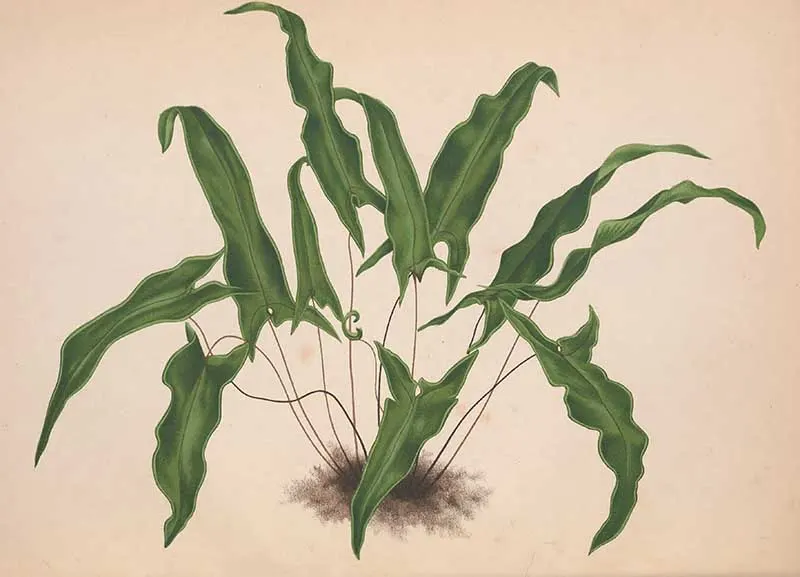
The Crown Fern or Blechnum discolor, is a New Zealand native fern known for its distinctive form. Unlike other ferns, it features a short trunk from which fronds sprout, forming a ‘crown’. These fronds, bright green on top and silvery underneath, can reach 1 meter in length.
You’ll find more vintage potted plant illustrations in this collection of tropical house plant drawings.

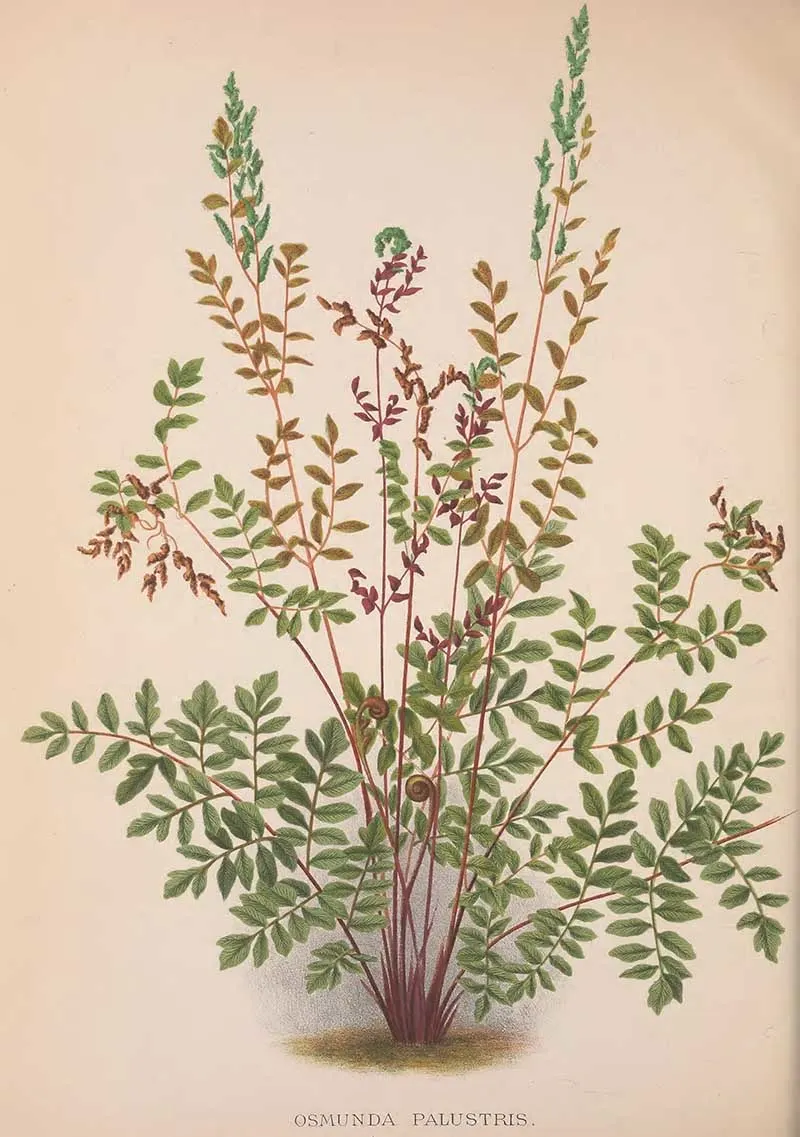
Print 19: Potted Blackfoot Polypody
Blackfoot Polypody is a fern native to Mexico and Central America, often found in tropical rainforests. As an epiphyte, it grows on other plants, mainly trees, drawing nutrients from air, rain, and surrounding debris.
Notable for its leathery, deeply lobed fronds, which can display a dark, almost black colour, it reproduces through wind-dispersed spores. Despite its tropical origins, it can be cultivated with high humidity, indirect light, and good air circulation conditions, making it a unique addition to a terrarium or indoor plant collection.
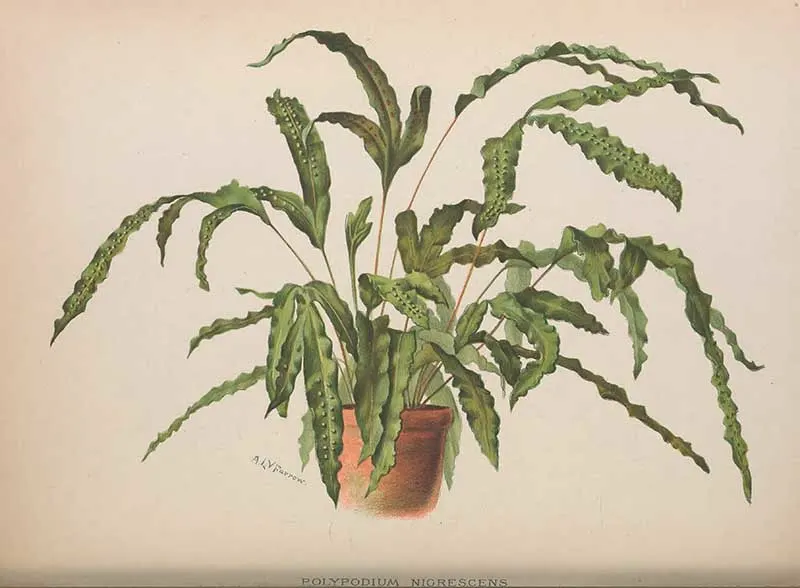
The Crested Royal Fern, or Pteris regina-cristata, is a rare fern known for its deeply cut, fringed, and curly fronds, giving it a textured appearance. This tropical fern enjoys a warm, humid environment, well-draining soil, and indirect sunlight.
While relatively hardy and adaptable, it’s not frost-tolerant and needs protection in colder climates.

Giant Spikemoss is native to Asia, notable for its large size. Its bright green, scale-like leaves and rosette pattern presents a lush appearance. This plant thrives in warm, humid environments with indirect sunlight and organically rich, well-draining soil.
While it can endure cooler temperatures, it’s frost-sensitive. Propagation can be via division or spores, the latter more challenging. Due to its high humidity preference, it’s popularly used as a houseplant in shade gardens or terrariums.

Other Vintage Botanicals
There is a tutorial here on how to draw ferns.
These fern prints are an excellent resource for botanical crafts.
Don’t forget to check out the other vintage botanical illustrations on the site, all in the Public Domain. Which include the works of other Victorian Botanists such as Joseph Paxton and his Flower Garden prints.
If you liked these wonderful vintage fern drawings and paintings, you should check out the vintage palm trees, antique botanical leaf prints and woodland botanical prints.
Some very popular vintage botanical posters are on the site, including the vintage tree posters from Larousse and those of Adolphe Millot.
If you fancy, you can Buy Me A Coffee Here.

G'ma Pat
Tuesday 27th of February 2024
OK, darn it, you did it again! I've been wanting a couple of fern pages for my woodland journal, and here they are. Problem is, they are all so beautiful I can't decide on only two. HELP!
claire
Tuesday 27th of February 2024
Thank you, yes they are lovely prints.
Food nutters
Saturday 5th of August 2023
Awwww, these look gorgeous. Thank you for sharing; I love plants on wall photos.
claire
Tuesday 8th of August 2023
Me too! Thank you.
Nancy Andres
Wednesday 2nd of August 2023
Oh my oh my. What an excellent post, filled with a large amount of info and vintage fern prints in this post. Never realized there are so many types of ferns. Saw it at Wonderful Wed. (aug 2). My posts are #52, 53, 54, and 55. Wishing you and your readers a beautiful day.
claire
Thursday 3rd of August 2023
Thank you so much; glad you enjoyed the fern pictures.
EsmeSalon
Friday 28th of July 2023
Gorgeous and beautifully done. I love ferns Thank you from your SSPS Team for sharing your links with us at #271 SSPS Linky.
claire
Saturday 29th of July 2023
Thank you so much; ferns are lovely plants to have in the house.